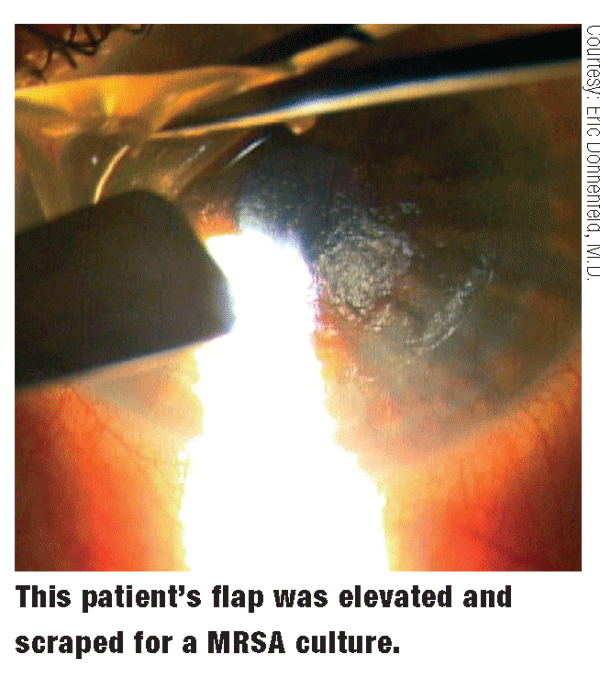 Q: There seems to be a troubling increase in methicillin-resistant Staphylococcus aureus (MRSA) infections outside the hospital setting. Whats happening? How can we treat patients who present with a MRSA infection?
Q: There seems to be a troubling increase in methicillin-resistant Staphylococcus aureus (MRSA) infections outside the hospital setting. Whats happening? How can we treat patients who present with a MRSA infection?
A: Resistant strains of Staphylococcus aureus developed in hospitals. These strains basically transferred out into the community, says Eric Donnenfeld, M.D., of Ophthalmic Consultants of Connecticut and
One difference between nosocomial MRSA and CA-MRSA is their susceptibility to antibiotics, says Francis Mah, M.D., of the
 Both Dr. Donnenfeld and Dr. Mah recommend oral vancomycin as a first-line treatment against MRSA because vancomycin-resistant S. aureus is, as yet, very rare.
Both Dr. Donnenfeld and Dr. Mah recommend oral vancomycin as a first-line treatment against MRSA because vancomycin-resistant S. aureus is, as yet, very rare.
One recent study measured the breakdown of HA- and CA-MRSA.2 Researchers found that the majority (85%) of MRSA infections in the nine communities studied were associated with a hospital or health-care setting, whether the infection manifested directly in the hospital setting or subsequently thereafter. Merely 13.7% of the MRSA infections observed were CA-MRSA, and only 1.3% of cases could not be verified.2
Were actually starting to see MRSA corneal ulcers now in contact lens wear, says Dr. Donnenfeld. These ulcers appear no different than the average infectious keratitis, but they can be more aggressive, and there is no way to differentiate them without performing cultures. And, for patients who have more aggressive infections, Id suggest that we should be using antibiotics that treat MRSA earlier, he adds.
Make sure to consider MRSA early in your differential diagnosis of a suspicious ulcer if the eye looks especially toxic, says Dr. Mah.
Investigators are focusing on methods to avoid infection. One study found that the use of a portable high-efficiency particulate air filtration unit reduced the amount of MRSA infiltrates in hospital patients rooms.3
Good hygiene may also help. Practice excellent hygiene, says Dr. Mah. With contact lens wearers, thats especially important. Change the case regularly, dont top off the solution, wash your hands before you handle the lenses, etc. Patients can also use a foaming lid cleanser, such as SteriLid (Advanced Vision Research, Inc). Its an effective disinfectant and lid cleanser, and it has extraordinarily good activity against MRSA, Dr. Donnenfeld says.
Bottom line, when it comes to managing a case of MRSA, catch the infection earlyand consider the patients recent history. If a patient develops an infectious keratitis in a hospital or nursing home, or if an infection develops in a patient whos been immunosuppressed or who was on antibiotics previously, then that clinician should consider MRSA a possibility, Dr. Donnenfeld says.
1. File TM. Impact of community-acquired methicillin-resistant Staphylococcus aureus in the hospital setting. Cleve Clin J Med 2007 Aug;74 Suppl 4:S6:11.
2. Klevens RM, Morrison MA, Nadle J, et al. Active Bacterial Core surveillance MRSA Investigators. Invasive methicillin-resistant Staphylococcus aureus infections in the
3. Boswell TC, Fox PC. Reduction in MRSA environment contamination with a portable HEPA filter. J Hosp Infect 2006 May;63(1):47-54.

